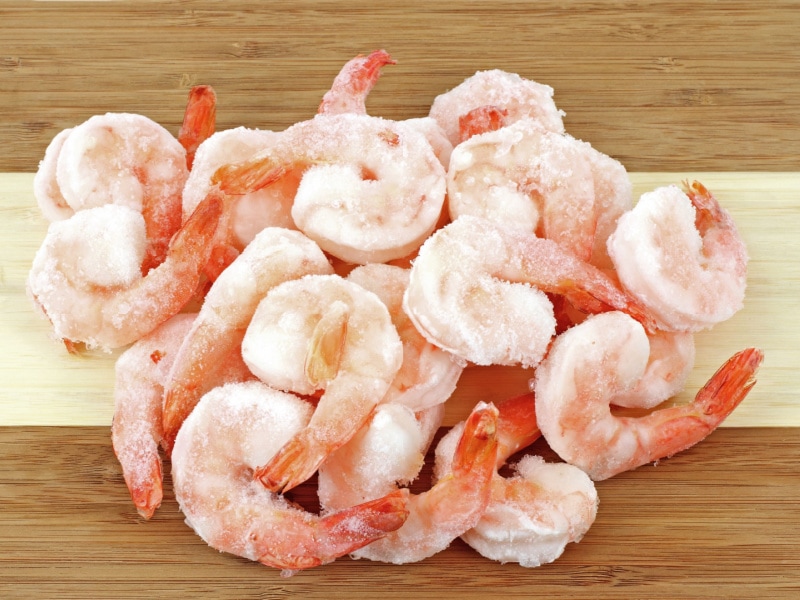Shrimp are nutritious, delicious and quick to prepare. Having them in your freezer gives you a lot more dinner options. They can make scampi, paella, fried rice, and gumbo taste better. But if your frozen shrimp smells fishy or has freezer burn, it has spoiled and should be discarded.
Shrimp is a delicious and versatile seafood ingredient used in everything from scampi to shrimp salad sandwiches. Its convenient frozen form allows you to enjoy shrimp any time without worrying about sourcing fresh seafood. But does frozen shrimp last forever in the freezer, or can it go bad?
I decided to do some digging on proper frozen shrimp storage and signs of spoiled shrimp. Here’s a comprehensive guide on how long frozen shrimp keeps, how to tell if your shrimp has gone south, and tips to extend its shelf life. Let’s dive in!
Why Freeze Shrimp in the First Place?
Shrimp has a very short shelf life in its fresh form Raw shrimp from the seafood counter will only last about two days refrigerated before spoiling,
Freezing is the best way to preserve shrimp quality and prevent waste. Frozen shrimp locks in flavor and texture for a good while, allowing you to buy large bags for long term storage.
Another benefit of frozen shrimp is it’s typically flash frozen very soon after being caught. This quick freezing helps maintain freshness. Refrigerated shrimp may sit longer before being put on ice.
Does Frozen Shrimp Expire?
Yes, frozen shrimp can eventually expire and is not good indefinitely. Shrimp will stay safe in the freezer for about 3 to 6 months until slowly deteriorating in quality.
How long frozen shrimp lasts depends on a few factors:
-
Freshness before freezing – Fresher shrimp frozen quickly after catching will last longer. Shrimp frozen at peak quality retains its texture better.
-
Freezer temperature – Colder freezers (-10°F to 0°F) keep food fresher than warmer units closer to 32°F. Store shrimp in the coldest part of the freezer.
-
Package integrity – Unbroken freezer bags or airtight containers prevent freezer burn. Loose packaging accelerates quality loss.
-
Freeze-thaw cycles – Repeated thawing and re-freezing degrades texture and makes shrimp dry. Minimize cycles for maximum shelf life.
While frozen shrimp won’t make you sick beyond 3-6 months, its taste and texture will slowly diminish over time.
How to Tell If Frozen Shrimp Has Gone Bad
Spoiled shrimp isn’t always clearly rancid, but there are a few signs to watch out for:
-
Altered color – Fresh shrimp is translucent with a grayish, pinkish hue. Off-colored blotches or an opaque, milky appearance indicates spoilage.
-
Soft texture – Frozen shrimp will be firm and solid. A mushy or stringy texture is a red flag.
-
Strange odor – Shrimp naturally has a briny, seafood scent that shouldn’t be overpowering. An ammonia-like, fishy or cloying smell means toss it.
-
Frozen into a solid block – Completely frozen-solid shrimp is a sign it’s old. Difficulty separating and peeling also indicates excessive freezer time.
-
Dried out appearance – Excessive freezer burn causes shriveling and dry spots. This accelerates quality deterioration.
When in doubt, remember the old adage – “If it smells bad, don’t eat it!” Rely on your senses, and don’t risk foodborne illness.
Can You Safely Eat Expired Frozen Shrimp?
Eating spoiled shrimp that’s a few months past its prime likely won’t make you sick or harm you. Shrimp don’t tend to harbor pathogenic bacteria in the way that chicken or red meat can.
However, the taste and texture will be poor, making meals unappetizing. I don’t recommend knowingly cooking with subpar ingredients.
If shrimp has been frozen for over 6 months, it’s best to toss it out rather than risk an awful seafood dish. Don’t bother with very old, questionable shrimp.
Storing Shrimp for Maximum Freshness
To get the longest safe shelf life out of frozen shrimp:
-
Buy frozen shrimp as soon as possible after it was caught and processed. Check for a frozen-on date.
-
Inspect packaging for integrity before buying. Avoid torn bags or opened boxes. Re-wrap if needed.
-
Use oldest shrimp first and don’t overstock your freezer. Organize shrimp by dates for easy identification.
-
Keep freezer set at 0°F if possible. Use a thermometer and adjust the temperature as needed.
-
Seal containers tightly every time and minimize opening the freezer. Limit air exposure.
-
Once thawed, use shrimp within 1-2 days and don’t refreeze. Refreezing causes major texture issues.
Follow these guidelines, and your shrimp will stay fresher for longer.
Safe Defrosting and Handling of Frozen Shrimp
Along with maximizing freezer time, proper defrosting and handling prevents contamination:
-
Thaw frozen shrimp overnight in the fridge, not on the counter. Don’t microwave as it alters texture.
-
Once thawed, use shrimp immediately. Don’t leave it sitting in the fridge.
-
Discard any juices from thawed shrimp, which can harbor bacteria. Rinse shrimp before cooking.
-
Cook shrimp thoroughly until opaque and buttery. Undercooking poses a food poisoning risk.
-
When reheating cooked shrimp, use proper temps and don’t let it sit at room temp more than 2 hours.
These practices keep thawed shrimp safe and fresh until it hits the pan or grill.
Signs You’ve Eaten Bad Shrimp
Hopefully you’ll never experience this, but here’s what to watch for if you consume spoiled shrimp:
-
Nausea, vomiting, and diarrhea – Usually within 1-2 hours of eating bad shrimp, food poisoning symptoms arise. This is common with any spoiled meat.
-
Abdominal cramps and pain – Your stomach will make it known something is wrong.
-
Fever and chills – Bacteria from spoiled food can cause infection-like fever symptoms in some cases.
If food poisoning symptoms last over 24 hours or you develop a fever, seek medical care rather than waiting it out. Drink plenty of fluids and call your doctor with concerns.
The Bottom Line
Shrimp can go bad in the freezer over time, but its shelf life is much longer than fresh shrimp. For best quality and safety, use frozen raw shrimp within 3-6 months.
Monitor smell, color, and texture for signs of spoilage. Be diligent with freezer temps and packaging. Handle thawed shrimp properly to prevent illness.
With smart storage and handling, frozen shrimp stays fresh and delicious for several months past its catch date. Just remember – when in doubt, throw it out!

Selecting and Storing Frozen Shrimp
Video of the Day
You can either buy shrimp frozen, raw or alive. According to the Food and Drug Administration (FDA), if you purchase shrimp raw — whether your intent is to cook or freeze them once you get home — make sure the shrimp is kept over ice at the store and has a pearl-like color with little or no odor. Purchasing live shrimp is rare. But if you decide to go this route, check for leg movement to ensure the shrimp are still alive and have not begun spoiling.



Video of the Day
According to the Auguste Escoffier School of Culinary Arts, frozen shrimp are actually fresher than “fresh” shrimp. This is because the frozen shrimp you see at the grocery store are usually thrown on ice immediately after they are caught or harvested and are kept frozen until they are sold. Shrimp that is sold raw on the other hand is most often frozen upon harvest, and then thawed before being sold. The raw shrimp have more time to spoil.
The FDA also says that frozen seafood can go bad, especially if it is left out in the warm for too long before being cooked. This can happen when shrimp thaws on the way from the fishing port to the store or from the store to your home.
For frozen shrimp that can be bent, freezer burn is a red flag. So are packages that are torn or open. Do not buy or use frozen shrimp if you notice any of these signs. Also, if you see that the “use by” date on the frozen shrimp package has passed, throw away the package and don’t eat the shrimp.
Once home, store frozen shrimp in moisture-free, tightly sealed plastic, foil or paper. When you’re ready to cook, put frozen shrimp in the fridge overnight to thaw slowly. If you need to cook it faster, put it in a plastic bag and put it in cold water. If you want to cook the shrimp right away, you can put it in the microwave and heat it on “defrost” until it’s still cold but not frozen.



Black Spots on Shrimp
If you find or are worried about black spots on shrimp, you have nothing to worry about if the spots are found on the shell. According to Louisiana Fisheries Forward, shrimp can occasionally have a discolored shell called black spot or melanosis.
This does not signify spoilage or the presence of bacteria. Instead, these black spots are caused by an enzymatic reaction between naturally occurring amino acids and sunlight. Shrimp with melanosis on the shell are still safe to eat. Some shrimp are processed with sulfites to prevent melanosis. If the shrimp you’re buying were treated with sulfites, it will say so in the list of ingredients. This is because sulfites are an allergen.
You can tell when shrimp are dead by the fact that their heads start to turn black if they are bought alive in their shells. The shrimp meat is still fresh and safe to eat if this starts to happen as long as only the head has turned dark.
How do you tell if cooked frozen shrimp is bad?
Does frozen shrimp go bad?
Discoloration, foul odor, and overly fishy smell are indicators that the frozen shrimp has gone bad. It is generally not advised to consume frozen shrimp after two years of storage. Does Frozen Shrimp Expire? Frozen shrimp does not have a specific expiration date, but it is best consumed within a certain timeframe.
Is shrimp healthy or harmful to health?
Shrimp is a versatile healthy high-protein food option. Shrimp contains moderate amounts of vitamin B12 and selenium while also being low in saturated fat. The concentration of cholesterol in shrimp may present an issue for individuals with type 2 diabetes or those with already unhealthy lipid profiles, but only likely if consumed in excess and in the context of an already unhealthy dietary pattern. Individuals with an allergy to shellfish should avoid shrimp altogether. Long term personal health partly depends on the ongoing health of the environment through sustainable action. Individuals concerned about consuming sustainable shrimp can look for the blue Marine Stewardship Council(MSC) certified stamp on the label.
Does frozen shrimp expire?
When it comes to frozen shrimp, the expiration date printed on the packaging serves as a guideline for optimal freshness. However, it doesn’t mean that the shrimp will instantly turn bad once that date has passed. The shelf life of frozen shrimp can be extended, allowing you to still enjoy them safely. The key lies in proper storage and handling.
How do you know if a frozen shrimp is safe to eat?
Look out for freezer burn. This can happen when the shrimp has been in the freezer for too long, usually more than 3 months. Be on the lookout for any signs of spoilage, such as a funky smell or discoloration. This is similar to what you’d see in fresh shrimp and is an indication that the shrimp is not safe to eat. Use your senses!
